
A sound film is a motion picture with synchronized sound, or sound technologically coupled to image, as opposed to a silent film. The first known public exhibition of projected sound films took place in Paris in 1900, but decades passed before sound motion pictures became commercially practical. Reliable synchronization was difficult to achieve with the early sound-on-disc systems, and amplification and recording quality were also inadequate. Innovations in sound-on-film led to the first commercial screening of short motion pictures using the technology, which took place in 1923. The sound film was also played with organs or pianos in the actual movie to represent sound.
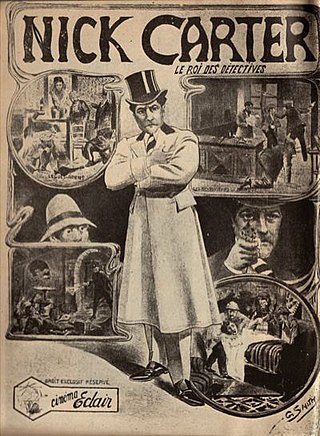
A mystery film is a genre of film that revolves around the solution of a problem or a crime. It focuses on the efforts of the detective, private investigator or amateur sleuth to solve the mysterious circumstances of an issue by means of clues, investigation, and clever deduction. By 2022, mystery films are generally referred to as detective fiction.

The Singing Fool is a 1928 American sound part-talkie musical drama motion picture directed by Lloyd Bacon which was released by Warner Bros. In addition to sequences with audible dialogue or talking sequences, the film features a synchronized musical score and sound effects along with English intertitles. The soundtrack was recorded using the Vitaphone sound-on-disc system. The film stars Al Jolson and is a follow-up to his previous film, The Jazz Singer. It is credited with helping to cement the popularity of American films of both sound and the musical genre.

Lights of New York is a 1928 American crime drama film starring Helene Costello, Cullen Landis, Wheeler Oakman and Eugene Pallette, and directed by Bryan Foy. Filmed in the Vitaphone sound-on-disc sound system, it is the first all-talking full-length feature film, released by Warner Bros., who had introduced the first feature-length film with synchronized sound Don Juan two years earlier, and the first with spoken dialogue, The Jazz Singer, one year earlier. The film, which cost $23,000 to produce, grossed over $1 million. The enthusiasm with which audiences greeted the talkies was so great that by the end of 1929, Hollywood was producing sound films exclusively.

My Man is a 1928 black and white sound part-talkie American comedy-drama musical film directed by Archie Mayo starring Fanny Brice and featuring Guinn "Big Boy" Williams. In addition to sequences with audible dialogue or talking sequences, the film features a synchronized musical score and sound effects along with English intertitles. The soundtrack was recorded using the Vitaphone sound-on-disc system.
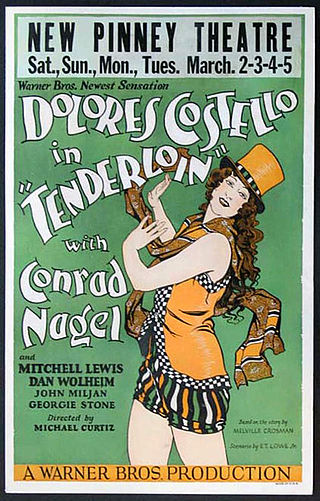
Tenderloin is a 1928 American sound part-talkie crime film directed by Michael Curtiz and starring Dolores Costello. In addition to sequences with audible dialogue or talking sequences, the film features a synchronized musical score and sound effects along with English intertitles. The soundtrack was recorded using the Vitaphone sound-on-disc system. It was produced and released by Warner Bros. Tenderloin is considered a lost film, with no prints currently known to exist.
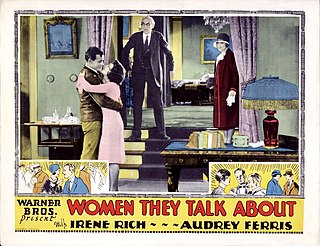
Women They Talk About is a 1928 American sound part-talkie comedy drama film directed by Lloyd Bacon and starring Irene Rich and Audrey Ferris.In addition to sequences with audible dialogue or talking sequences, the film features a synchronized musical score and sound effects along with English intertitles. The soundtrack was recorded using the Vitaphone sound-on-disc system. The film was produced and distributed by Warner Bros. It is considered to be a lost film.
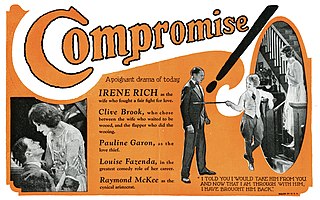
Compromise is a 1925 American silent drama film directed by Alan Crosland and produced and distributed by Warner Bros. The film was based on the 1923 novel of the same name by Jay Gelzer.

Dearie is a 1927 American silent drama film produced and distributed by Warner Bros. and directed by Archie Mayo. It is from a story by Victorian author Carolyn Wells about a woman who sacrifices for her ungrateful son. This film starred Irene Rich and it is possible that the film may have been released with a Vitaphone soundtrack.

State Street Sadie is a 1928 American sound part-talkie crime drama film directed by Archie Mayo. In addition to sequences with audible dialogue or talking sequences, the film features a synchronized musical score and sound effects along with English intertitles. The soundtrack was recorded using the Vitaphone sound-on-disc system. This is regarded as a lost film.
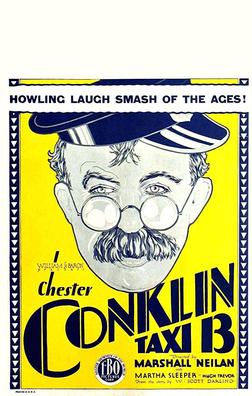
Taxi 13 is a 1928 sound part-talkie film comedy produced and distributed by Film Booking Offices of America and directed by Marshall Neilan. In addition to sequences with audible dialogue or talking sequences, the film features a synchronized musical score and sound effects along with English intertitles. The soundtrack was recorded using the RCA Photophone sound-on-film system. The film stars Chester Conklin in what is FBO's first film with a pre-recorded soundtrack.
House of Horror is a 1929 American sound part-talkie comedy mystery film directed by Benjamin Christensen. In addition to sequences with audible dialogue or talking sequences, the film features a synchronized musical score and sound effects along with English intertitles. The soundtrack was recorded using the Vitaphone sound-on-disc system. The film stars Louise Fazenda and Chester Conklin. The film portion of the House of Horror is now presumed lost while the sound survives on Vitaphone discs.
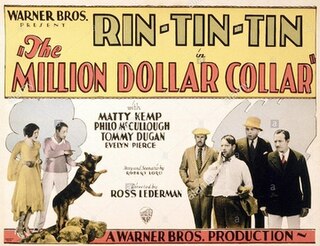
The Million Dollar Collar is a 1929 American sound part-talkie crime film directed by D. Ross Lederman. In addition to sequences with audible dialogue or talking sequences, the film features a synchronized musical score and sound effects along with English intertitles. The soundtrack was recorded using the Vitaphone sound-on-disc system. The film is in unknown status which suggests that it may be lost. According to Warner Bros records the film earned $222,000 domestically and $90,000 foreign.

The Man and the Moment is a formerly lost 1929 sound part-talkie romantic comedy film directed by George Fitzmaurice and starring Billie Dove. In addition to sequences with audible dialogue or talking sequences, the film features a synchronized musical score and sound effects along with English intertitles. The soundtrack was recorded using the Vitaphone sound-on-disc system. The film survives in a copy of the International Sound Version. The sound of the domestic part-talkie version was synchronized to the surviving print of the international sound version. Because of this, many scenes feature intertitles shown immediately after the spoken dialogue conveying the same words. The talking sequences on the international sound version were muted with music and intertitles were inserted to convey the dialogue replaced in the appropriate foreign language. Therefore, intertitles were left in the talking sequences during the restoration to maintain synchronization with the Vitaphone soundtrack. The story is from a 1914 novel by Elinor Glyn, the famous novelist. The film was produced by Richard A. Rowland and released by First National Pictures. A British silent film had been film of the same story in 1918.
The Greyhound Limited is 1929 part-talkie talkie crime drama and railroad theme film directed by Howard Bretherton and starring Monte Blue. In addition to sequences with audible dialogue or talking sequences, the film features a synchronized musical score and sound effects along with English intertitles. The soundtrack was recorded using the Vitaphone sound-on-disc system. The film was produced and distributed by Warner Bros.. The film is a follow-up to the 1927 film The Black Diamond Express.

The Pleasure Buyers is a 1925 American silent mystery drama film directed by Chester Withey and starring Irene Rich, Clive Brook, and Gayne Whitman. It was made by Warner Bros. In 1926 it was released in Britain by Gaumont British Distributors.

Craig's Wife is a 1928 American silent drama film directed by William C. deMille and starring Irene Rich, Warner Baxter and Virginia Bradford. It was based on the 1925 play Craig's Wife by George Kelly. Subsequent film adaptations followed in 1936 as Craig's Wife and 1950 as Harriet Craig. It is now considered a lost film.

A Voice in the Dark is a 1921 American black-and-white silent mystery film directed by Frank Lloyd and starring Ramsey Wallace, Irene Rich, and Alec B. Francis. The film is based on the play A Voice in the Dark by Ralph E. Dyar.

Saturday's Children is a 1929 American sound part-talkie romantic-comedy film directed by Gregory La Cava, and starring Corinne Griffith, Grant Withers, Albert Conti, Alma Tell, Lucien Littlefield. In addition to sequences with audible dialogue or talking sequences, the film features a synchronized musical score and sound effects along with English intertitles. The sound was recorded via the Vitaphone sound-on-disc process. The film was released by Warner Bros. on April 14, 1929. The film is based on the 1927 play Saturday's Children by Maxwell Anderson.

The Girl in the Glass Cage is a 1929 American sound part-talkie crime drama film directed by Ralph Dawson and starring Loretta Young, Carroll Nye, Matthew Betz, Lucien Littlefield, and Ralph Lewis. In addition to sequences with audible dialogue or talking sequences, the film features a synchronized musical score and sound effects along with English intertitles. The soundtrack was recorded using the Vitaphone sound-on-disc system. It is based on the 1927 novel of the same name by George Kibbe Turner. The film was released by Warner Bros. on June 23, 1929.


















